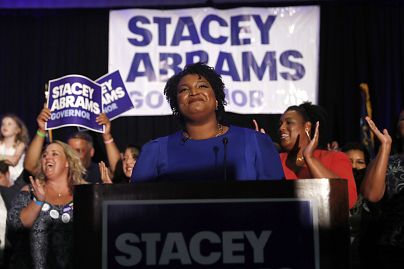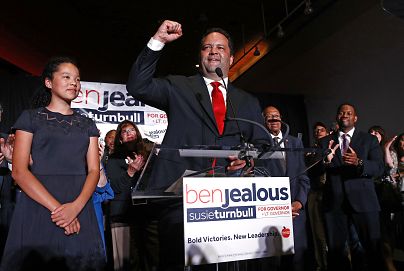African-Americans running on the left have notched a string of victories this year. Here's why.
Bernie Sanders couldn't carry JFK's old congressional district in Massachusetts when he ran against Hillary Clinton in 2016, but Ayanna Pressley did — and her stunning primary upset this week adds to a string of victories for underdog progressive black Democrats this year.
It took a combination of a surge in turnout from people of color and young white progressives for Pressley, the first black woman on the Boston City Council, to oust a 10-term white incumbent. She'll now become the state's first black woman in Congress, since there is no Republican on the ballot in the heavily Democratic House district.
This year, it's progressive African-Americans who are responsible for nearly all of the insurgent left's successes in party primaries.
With Andrew Gillum in Florida, Stacey Abrams in Georgia, and Ben Jealous in Maryland, voters in three states could elect black governors in November — even though the county has only ever elected two in its history.
It's been a good year for black Democrats, but it's also a roadmap for the future of the progressive movement and the Democratic Party, activists say. Democrats in all three gubernatorial primaries are running as full-throated progressives who challenged more traditional candidates in states where the party typically nominates moderates.
White progressive insurgents, meanwhile, have had less luck this year, sometimes bumping up against a ceiling that white liberals alone can't surpass.
Maurice Mitchell, a Black Lives Matter activist who recently took the helm of the progressive Working Families Party, sees the emergence of what he calls "the Obama coalition, plus."
Barack Obama beat Hillary Clinton 2008 by combining the strengths of people of color and younger white progressives, but he governed from the center-left. He watched the rise of social movements like Occupy Wall Street, Black Lives Matters and the Women's March, not to mention political movements like Sanders, all of which have added intensity and urgency to the left.
"The electoralisition of these people will mean they'll govern very differently from how Obama did," said Mitchell, who took over the WFP, which backed Sanders over Clinton, specifically to help it build a more multiracial coalition.
The problem with the Obama coalition, electorally, was that it was nearly impossible to replicate.
"Everybody was trying to recreate the Obama coalition and couldn't," said Karine Jean-Pierre, a alumna of both Obama campaigns and the White House who is now a senior adviser to MoveOn.org. "Only if he was on the ticket was that coalition enthusiastic and ready to go."
That's especially been true for people of color.
At Aretha Franklin's funeral Friday, the Rev. Jesse Jackson lamented the long lines he saw to honor the singer in death, but not at polling places. "If you leave here today and don't register to vote, you're dishonoring Aretha," he said.
With perhaps the exception of Obama, black political leaders have tended to align with the center of the Democratic party, noted Melanye Price, who teaches Africana studies and political science at Rutgers University and wrote a book about Barack Obama and race.
That's how Hillary Clinton, who nearly consolidated African-American vote in 2016, beat back Sanders and his army of disproportionately younger, whiter revolutionaries.
In Massachusetts, the Congressional Black Caucus backed Rep. Mike Capuano, D-Mass., the white incumbent, over Pressley. And the CBC also pushed to preserve the power of superdelegates in the Democratic presidential nominating process, even as younger black delegates to the Democratic National Committee fought to end them (the DNC voted last month to strip their power).
But that's changing, according to Price, thanks to a new generation of black leaders who stepped in a power vacuum created when traditional civil rights organisations, like the NAACP, decided to work inside the system in the Obama era.
"It's clear that the era of centrist black politicians is on the wane. The time of black progressives is in ascent," Price wrote in an op-ed for the New York Times on Wednesday. "The old political orthodoxy that has allowed black centrist Democrats to dominate black politics is being dethroned."
Still, this year's primaries also show that people of color alone are not enough to win on their own.
While whites make up only 42 percent of residents in Pressley's district, the electorate has remained stubbornly white: 55 percent of registered voters, according to WBUR. And precinct-level data shows Pressley was likely dependent on white progressives voters in places with few minorities, like Sommerville.
Alexandria Ocasio-Cortez, who beat powerful white incumbent in New York City earlier this year, owes her success in no small part to gentrifiers.
Abrams' is hoping to tap the hundreds of thousands of black Georgians who don't typically vote — but she makes no secret about also needing college-educated white suburbities and younger voters.
That will be especially true too for Gillum in Florida, where whites make up 77 percent of the state and blacks are just 17 percent.
A newQuinnipiac Poll showed Gillum narrowly leading his opponent, Rep. Ron DeSantis, R-Fla. Unsurprisingly, it showed him cleaning up with black voters, but he was weak among Latinos. So how was he winning overall then?
As demographer Ruy Teixeira noted, it's because the poll showed him overperformaning among whites compared to Hillary Clinton.
That's unexpected, and could still be a polling error, for a candidate who is running on Medicare for All, marijuana legalisation and sweeping criminal justice reform in a state where Democrats have tended to nominate moderate white candidates for fear of alienating white voters.
If Gillum wins the country's biggest swings state on that platform, Jean-Pierre predicted, it will have lasting influence.
"Whatever happens in Florida this year is going to set the tone for 2020," she said.













